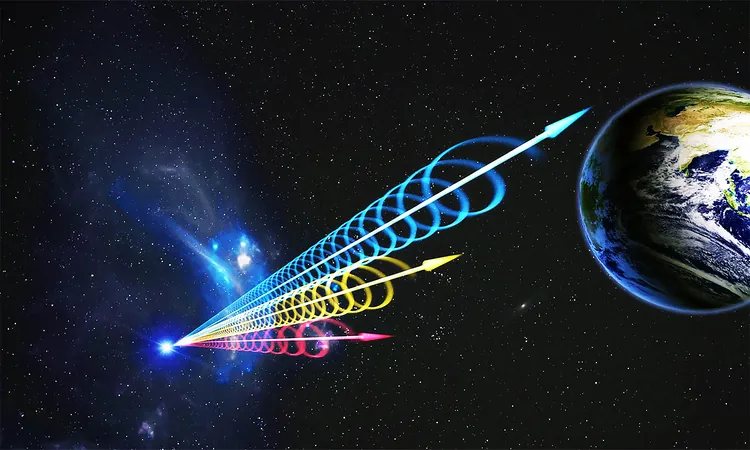
Groundbreaking Discovery: Ancient Deep Space Radio Signal Reaches Earth After 8 Billion Years!
2024-09-21
Author: Ying
Groundbreaking Discovery: Ancient Deep Space Radio Signal Reaches Earth After 8 Billion Years!
In an extraordinary achievement, astronomers have detected a perplexing burst of radio waves that journeyed across the cosmos for an astounding 8 billion years before reaching Earth. This celestial event, referred to as FRB 20220610A, stands as one of the most distant and powerful radio signals ever recorded.
Fast Radio Bursts (FRBs) like this one are intense, millisecond-long flashes of radio energy. Though first identified in 2007, their origins remain shrouded in mystery, sparking intense speculation among scientists about who or what could be responsible for these enigmatic signals.
The implications of these signals are tremendous, as they originate from realms far beyond our Milky Way galaxy, offering tantalizing hints of cosmic processes and events that continue to elude our understanding. Dr. Stuart Ryder, a prominent astronomer at Macquarie University in Australia, is leading a dedicated team of scientists who are fervently working to unveil the secrets of this cosmic phenomenon.
Utilizing state-of-the-art technologies like the Australian Square Kilometre Array Pathfinder (ASKAP), the researchers pinpointed the origin of FRB 20220610A. Their efforts culminated in the identification of the source galaxy, which turned out to be older and more distant than any other FRB source documented previously. This discovery is a major leap forward in understanding the universe's deeper mysteries.
Unlocking the Universe's Secrets with FRBs
Researchers believe that FRBs have the potential to solve one of cosmology's biggest puzzles: the missing normal matter in the universe. Current models suggest an enormous gap between the matter we observe and what should logically exist. Professor Ryan Shannon from the Swinburne University of Technology explains that over 50% of normal matter is currently "missing," possibly hidden in regions of space that are too diffuse to detect with traditional methods.
This innovative research, rooted in the 2020 discovery known as the Macquart relation, establishes that FRBs can help detect and quantify the ionized matter residing in the emptiness between galaxies. The recent findings lend further credence to this relationship, even for bursts originating from halfway across the known universe.
The Future of FRB Research
So far, approximately 50 FRBs have been traced to their sources, with half of these identified using the ASKAP telescope. With new radio telescopes slated to debut soon, the astronomical community anticipates detecting thousands more FRBs, which could dramatically enhance our comprehension of the universe’s intricate structure.
Professor Shannon believes that these fast radio bursts can potentially create a new cosmic map, shedding light on various fundamental questions regarding dark matter, dark energy, and overall cosmic evolution.
Understanding the universe and identifying missing matter remain fundamental challenges for scientists. The universe is composed of a mere 5% visible matter—stars, planets, galaxies—while a staggering 95% is thought to be dark energy and dark matter, both elusive and undetectable by current technology. This significant deficit leaves astronomers pondering how the universe is truly structured.
Recent advancements in telescope technology have begun to unveil the elusive hydrogen clouds speculated to constitute a part of this "missing matter." Discovering what this matter entails and where it resides is critical to refining our models of cosmic evolution.
A Bright Horizon for Cosmic Exploration
As researchers push the boundaries of our current understanding, each new FRB detection paves the way for profound revelations about the universe. These cosmic flashes, although fundamentally mysterious, are opening doors to answer pivotal questions about the forces that mold our cosmos.
As we stand on the brink of a new era in astrophysics, the possibilities that FRBs offer seem limitless. With future telescopes promising to extend our grasp even further into the fabric of the universe, the exciting adventure of FRB research is only just beginning. Therefore, while we have amassed significant knowledge, we are also reminded of how much remains shrouded in mystery.
Stay tuned for more groundbreaking updates as scientists delve deeper into the cosmic enigma that is fast radio bursts!
This groundbreaking research was published in the esteemed journal Science.






 Brasil (PT)
Brasil (PT)
 Canada (EN)
Canada (EN)
 Chile (ES)
Chile (ES)
 Česko (CS)
Česko (CS)
 대한민국 (KO)
대한민국 (KO)
 España (ES)
España (ES)
 France (FR)
France (FR)
 Hong Kong (EN)
Hong Kong (EN)
 Italia (IT)
Italia (IT)
 日本 (JA)
日本 (JA)
 Magyarország (HU)
Magyarország (HU)
 Norge (NO)
Norge (NO)
 Polska (PL)
Polska (PL)
 Schweiz (DE)
Schweiz (DE)
 Singapore (EN)
Singapore (EN)
 Sverige (SV)
Sverige (SV)
 Suomi (FI)
Suomi (FI)
 Türkiye (TR)
Türkiye (TR)
 الإمارات العربية المتحدة (AR)
الإمارات العربية المتحدة (AR)